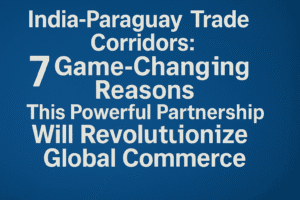India-Paraguay Trade Corridors: 7 Game-Changing Reasons This Powerful Partnership Will Revolutionize Global Commerce
India and Paraguay are forging a significant multi-sector partnership leveraging mutual strengths. Key areas include digital technology, where India’s proven Digital Public Infrastructure (DPI) can aid Paraguay’s transformation, and critical minerals, vital for India’s green transition and offering Paraguay value-added potential beyond raw exports. Enhanced cooperation in agriculture targets trade and tech exchange like agri-processing.
Crucially, Paraguay seeks Indian expertise in railway infrastructure, specifically for its role in the continent-spanning Bi-Oceanic Corridor project. Both nations committed to expanding the existing India-Mercosur trade agreement to boost market access. Existing business ties in biofuels, pharma, and auto sectors provide a foundation, reinforced by President Peña’s direct investment outreach to Indian businesses in Mumbai. This South-South alliance aims to transform geographic distance into strategic economic advantage with far-reaching implications.

India-Paraguay Trade Corridors: 7 Game-Changing Reasons This Powerful Partnership Will Revolutionize Global Commerce
The three-day visit of Paraguayan President Santiago Peña to India, culminating in Mumbai, signals far more than diplomatic pleasantries. As Prime Minister Narendra Modi highlighted, the two nations are actively forging a multi-dimensional economic partnership with significant potential to alter trade flows and development pathways in the Global South. Here’s the deeper significance:
- Strategic Synergy Over Surface-Level Cooperation:
- Digital Bridges: Paraguay, with its young, tech-adaptable population, sees India’s globally acclaimed Digital Public Infrastructure (DPI) stack as a blueprint for its own digital transformation. Collaboration isn’t just about exporting software; it’s about co-creating solutions for financial inclusion, e-governance, and efficient service delivery tailored to similar developing economies.
- Critical Minerals & Green Futures: India’s urgent need for lithium, cobalt, and other minerals essential for its EV and renewable energy ambitions meets Paraguay’s largely untapped geological potential. This isn’t merely trade; it’s about securing resilient supply chains for India while enabling Paraguay to move beyond raw material export towards potential value-added processing, guided by Indian expertise.
- Agricultural Powerhouses Converging: Paraguay is a global giant in soy, beef, and organic sugar. India, with its vast market and food processing capabilities, offers a lucrative destination. Beyond commodity trade, collaboration could involve Indian agri-tech in precision farming, cold chain logistics, and food processing within Paraguay, boosting productivity and reducing waste for both nations.
- Mercosur: The Crucial Gateway: India’s existing, albeit limited, Preferential Trade Agreement (PTA) with the Mercosur bloc (Brazil, Argentina, Paraguay, Uruguay, Bolivia) is the bedrock. Both leaders explicitly committing to “expand it” is pivotal. Deeper Indian access to this massive South American market hinges significantly on Paraguay’s support within the bloc. Conversely, Paraguay gains a powerful advocate for its exports within Asia’s fastest-growing major economy.
- Infrastructure & the Bi-Oceanic Vision: The mention of Indian involvement in Paraguay’s railway infrastructure, specifically as part of the ambitious Bi-Oceanic Corridor, is a game-changer. This corridor aims to connect Atlantic ports (Brazil) to Pacific ports (Chile/Peru) through Paraguay and Argentina. India’s cost-effective engineering prowess and railway modernization experience position it uniquely to help Paraguay realize its vision of becoming a vital continental logistics hub, reducing its landlocked disadvantage and opening new trade routes for Indian goods.
- Beyond Big Names: The Quiet Business Revolution: While major investments grab headlines, the existing foundation is crucial:
- Indian firms in Paraguay aren’t just present; they’re pioneers in sectors like biofuels (crucial for energy diversification) and affordable pharmaceuticals (improving healthcare access).
- Paraguayan businesses establishing joint ventures in India represent a two-way street of growing confidence and market understanding.
The Mumbai Connection: President Peña’s pivot to Mumbai, India’s financial powerhouse, underscores the visit’s core economic intent. Engaging directly with India’s top industrialists and financiers signals a serious push to translate governmental agreements into tangible investments across the discussed sectors.
The Road Ahead: More Than Just Potential
The “technical talks” planned to expand the India-Mercosur PTA are the immediate next step, crucial for unlocking market access. However, the true measure of success will be:
- Concrete Projects: Seeing Indian DPI implementations launched in Paraguay, joint ventures in critical mineral processing established, and Indian companies winning contracts on the Bi-Oceanic Corridor railway links.
- PTA Expansion: Achieving meaningful tariff reductions and broader product coverage within Mercosur, making Indian goods genuinely competitive and Paraguayan exports more attractive in India.
- Investment Flows: Significant follow-through on investment interests expressed in Mumbai, particularly in tech, agri-processing, and infrastructure.
This partnership transcends traditional North-South dynamics. It’s a pragmatic alliance between two geographically distant but strategically aligned developing nations. India gains a reliable partner in a resource-rich region and a gateway to Mercosur. Paraguay gains access to cutting-edge technology, infrastructure expertise, and a massive new market. If nurtured, this collaboration could become a blueprint for South-South cooperation, reshaping economic geography and proving that the most impactful trade corridors of the future might just bypass the traditional hubs altogether. The focus now shifts from exploring opportunities to delivering results.
You must be logged in to post a comment.